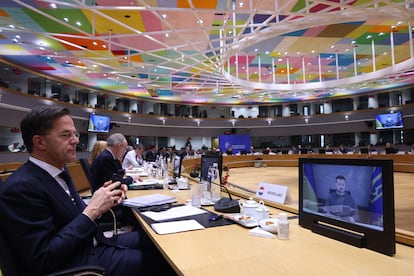European aid to Ukraine, an essential but insufficient lifeline for Kyiv’s war effort
The €50 billion agreed by EU leaders will allow Ukraine to resist on the front lines and support the public coffers, but Volodymyr Zelenskiy has stated that without U.S. support the war is lost

The new European Union aid package comes at a critical time for Ukraine. Its army is outnumbered, public debt is skyrocketing and in the United States, Democrats and Republicans seem far from reaching an agreement to sustain Washington’s support for Kyiv. The €50 billion ($54.4 billion) agreed Thursday by EU leaders for the next four years are an essential lifeline to maintain Ukrainian resistance on the front lines and to sustain the government’s budget. But this money alone will not be enough for Kyiv to meet its goals, the country’s leaders have warned.
The problem is that without the support of Washington, Ukraine has little chance of defending itself against the Russian invasion. This was noted on January 29 by President Volodymyr Zelenskiy in an interview with German broadcaster ARD. “Europe alone will not cope if U.S. support is suspended. Neither with weapons nor financially,” he warned. Kyiv was always confident the EU would circumvent the Hungarian veto, especially after last Monday’s meeting between the Hungarian and Ukrainian foreign ministers and Zelenskiy’s number two, Andrii Yermak.
Kyiv’s state budget for 2024 envisages revenues of €43.775 billion against expenditures of almost twice as much: €82.385 billion. Ukrainian Prime Minister Denys Shmyhal stated in a press release on January 26 that the government estimated €18 billion of the annual public deficit would be covered by the European package — i.e. 36% of the €50 billion committed up to 2027. Economy Minister Yulia Svyrydenko said Thursday that she expects a first tranche of €4.5 billion to arrive this March.
The Ukrainian public debt will be equivalent to 100% of GDP in 2024, compared to 48% before the Russian invasion, according to the International Monetary Fund (IMF). Forty-five percent of the 2024 budget, €37 billion, is earmarked for defense, equivalent to 22% of GDP. This is not only money for armaments, but above all for fuel, transportation, salaries, and maintenance of the nearly 880,000 men and women serving in the Armed Forces of Ukraine and other national defense corps.
According to the Washington-based Wilson Center think tank, Ukraine forecasts international defense aid will amount to 13% of GDP. Without this funding, the government will not be able to cover other fundamental pillars of the state at a time when unemployment has soared from 9.8% pre-war to 24.5% today, according to IMF data, and when millions of people displaced by the fighting are receiving subsidies as internal refugees.
Waning international aid
The transfer of international aid has decreased drastically since last autumn. The Kiel Institute for the World Economy in Germany, a leading think tank for monitoring economic and military support to Ukraine, estimated last December that between summer and autumn 2023, international assistance commitments to Kiev had dropped by 90%. From the beginning of the invasion in February 2022 until October 2023, shortly after the failure of the Ukrainian counteroffensive was confirmed, the EU had agreed to aid valued at €84.3 billion and the United States at €71.4 billion. Germany, the third largest donor, contributed €21 billion and the United Kingdom €13.3 billion.
Ukrainian fears are centered above all on what happens in Washington. The White House has budgeted $61 billion in assistance to Ukraine, a package that the Republican Party is blocking from the legislative branch amid demands that President Joe Biden and the Democrats agree to increase the security budget on the border with Mexico as a prerequisite to approving the package for Ukraine.
Zelenskiy said in Washington last September that without U.S. assistance, Ukraine would lose the war. The White House is Kyiv’s main military backer: in the first 20 months of the war, the United States committed €44 billion in armaments to Ukraine; the second largest supplier of military equipment was Germany, with €17.1 billion, according to the Kiel Institute. The EU, on the other hand, has contributed €77.1 billion.
Ukrainian Defense Minister Rustem Umerov this week issued a document to his EU counterparts in which he illustrates the disadvantages his troops face against Russian forces. The document, advanced by the Bloomberg agency, states that Moscow is able to triple the number of artillery shells fired by Ukraine — 6,000 per day compared to 2,000, according to Umerov’s report. The minister insists that Ukraine should at least have the same firepower available as the invader.
Russia is advancing again on the Donetsk and Kharkiv fronts, outnumbering Ukrainian forces in terms of infantry, air dominance with drones, armor, and artillery. According to an analysis published last December by the Stockholm International Peace Research Institute, the Russian military budget will exceed Ukraine’s by more than three times in 2024.
Military theory indicates that to be successful, an army on the offensive must be at least three times greater in terms of resources than the defending forces. A recurrent complaint from the Ukrainian political and military leadership is that its Western allies have never provided enough military aid to give Kyiv a clear superiority over Russia to be able to regain the occupied territories. “They have helped us to hold our own, but not to win,” Zelenski said in a recent interview. The Washington Post reported on January 26, citing unnamed U.S. government sources, that the Biden administration is planning assistance for Ukraine over the next decade just to defend itself, without contemplating the possibility that Kyiv might expel Russian forces from the territories occupied by Moscow.
Sign up for our weekly newsletter to get more English-language news coverage from EL PAÍS USA Edition
Tu suscripción se está usando en otro dispositivo
¿Quieres añadir otro usuario a tu suscripción?
Si continúas leyendo en este dispositivo, no se podrá leer en el otro.
FlechaTu suscripción se está usando en otro dispositivo y solo puedes acceder a EL PAÍS desde un dispositivo a la vez.
Si quieres compartir tu cuenta, cambia tu suscripción a la modalidad Premium, así podrás añadir otro usuario. Cada uno accederá con su propia cuenta de email, lo que os permitirá personalizar vuestra experiencia en EL PAÍS.
¿Tienes una suscripción de empresa? Accede aquí para contratar más cuentas.
En el caso de no saber quién está usando tu cuenta, te recomendamos cambiar tu contraseña aquí.
Si decides continuar compartiendo tu cuenta, este mensaje se mostrará en tu dispositivo y en el de la otra persona que está usando tu cuenta de forma indefinida, afectando a tu experiencia de lectura. Puedes consultar aquí los términos y condiciones de la suscripción digital.
More information
Archived In
Últimas noticias
There is as much life left to discover on planet Earth as that which is already known
Dozens presumed dead, around 100 injured in fire at Swiss Alps bar during New Year’s celebration
Is porn for women different from conventional porn? We spoke to those who make it
Cartagena de Indias is sinking: What can the city do to mitigate it?
Most viewed
- David King, chemist: ‘There are scientists studying how to cool the planet; nobody should stop these experiments from happening’
- Reinhard Genzel, Nobel laureate in physics: ‘One-minute videos will never give you the truth’
- Oona Chaplin: ‘I told James Cameron that I was living in a treehouse and starting a permaculture project with a friend’
- Sinaloa Cartel war is taking its toll on Los Chapitos
- The Interoceanic Train, the Mexican alternative to the Panama Canal











































